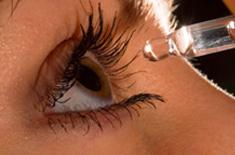| Dry Eye |
 |
|
|
| |
 |
What is it? |
| |
A dry eye syndrome is said to exist when the quantity, or the quality of the pre–
corneal tear film is insufficient to ensure the well-being of ocular epithelial surface.
In lay man terms, when we blink, a film of tears spreads over the eye, making the surface
of the eye smooth and clear, without this tear film, good vision would not be possible,
this condition is known as dry eye. |
 |
What Causes it? |
| |
Hormonal changes are a main cause of dry eye syndrome, causing changes in tear
production.
Diseases associated with decrease corneal sensation.
A wide variety of common medications can cause dry eye by reducing tear secretions like
diuretics for high blood pressure, beta- blockers for cardiac diseases, antihistamines for
allergy, sleeping pills, anti - anti-anxiety medications, pain relievers .
Exposure to dry, windy climate as well as smoke and air conditioning which can speed
tear evaporation can also be the cause of dry eye.
|
 |
Who are at risk? |
| |
People who have Sjogren’s syndrome usually have dry eye. Systemic diseases like
lupus, rheumatoid arthritis, thyroid disease,npeople with post refractive or lasik surgery
can also experience dry eye, long term contact lens wear and people who are sensitive to
certain climates such as windy, dry air, cigarette smoke and air conditioning. |
 |
What are the symptoms & signs? |
| |
Symptoms
1-Foreign body sensation(sandy or gritty feeling).
2- Transient blurring of vision.
3- Excessive stringy mucus.
4- Burning sensation.
5- Photophobia
6- Intolerance to smoke and winds.
7-Discomfort when wearing contact lenses.
Signs
1-Pre-corneal tear film –Increase amounts of mucus strands and debris in the upper and
lower tear menisci.
2- Marginal Tear Strip- Marginal tear strip is reduced,and it contains mucus and debris.
3-Conjunctiva- Hyperaemia of the conjunctiva, appearance of foldas on temporal
side ,specially on abduction , papillary conjunctivitis.
|
 |
How is it diagnosed? |
| |
Dry eye condition is diagnosed with the help of
1. Schirmer’s test
A 5mm wide and 35mmlong,special fiter paper is placed in the
lower fornix at the junction of the middle and outer third of the eye lid ,after folding it
5mm.After 5minutes ,the amount of wetting from the fold is measured. Normal value
ranges from 11-25 mm, Borderline 5-10mm and impaired secretion less than 5mm .
Schirmer’s test 1 measures basic secretion and schirmer’s test 2 measures reflex
secretion.
2. Tear film break up time (TBUT)
A drop of fluoroscein is instilled, and the patient is asked to blink 2-3 times to distribute
the dye .The patient is then asked not to blink while the cornea is studied by a cobalt blue
filter with the slit lamp. The BUT is the break up time in seconds,between the last blink
and the appearance of dry (black )spots.Anormal BUT is more than 10 seconds (15 to 35
seconds), and BUT value less than 10 seconds is abnormal.
3. Vital dye staining
(Fluoroscein 2% and Rose Bengal 1% staining patterns. |
 |
What is the treatment? |
| |
Treatment depends upon the cause of optic nerve disorders. Vision is required for
communication, access to information, and mobility. The maximum distance at which
faces can be seen, and facial expressions seen and learned from, needs to be determined
and conveyed to parents and carers. The language framework required to compensate for
reduced vision should be established. The size and contrast, and the proximity of toys and
printed information required for maximum speed of access to the information need to be
determined. The provision of low-vision aids at an early stage warrants consideration.
The visual limitations to all aspects of mobility need to be understood and compensated
for |
 |
What are the surgical options? |
| |
Tarsorrhaphy, to prevent exposure keratitis.
Lid taping.
Punctal occlusion . |
 |
What are the outcomes? |
| |
Ans-The results may vary from patient to patient .Ophthalmologists must actively
encourage these patients to continue to persue their normal activities.
|
 |
What are the complications? |
| |
Keratitis(ulceration of the cornea), blepharitis, conjunctivitis etc. |
 |
What is the time course? |
| |
The answer to this depends on the severity and strength of eye disease. Firstly
consultation is required with an ophthalmologists and relevant follow ups visits as per his
advise. |
 |
What is the expense? |
| |
The expense depends upon the grades of treatment. |
|
| |
Author: Dr. Sanjay Dhawan
Last Updated on: 1 March, 2014 |
| |
|
|
|
